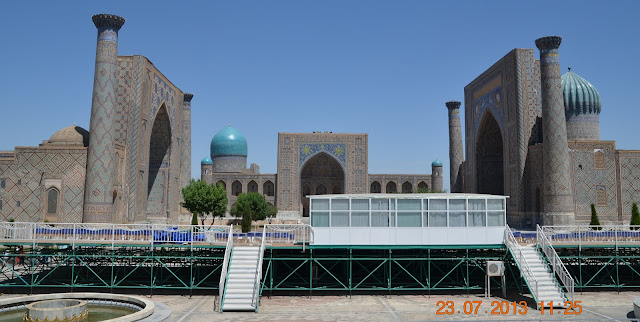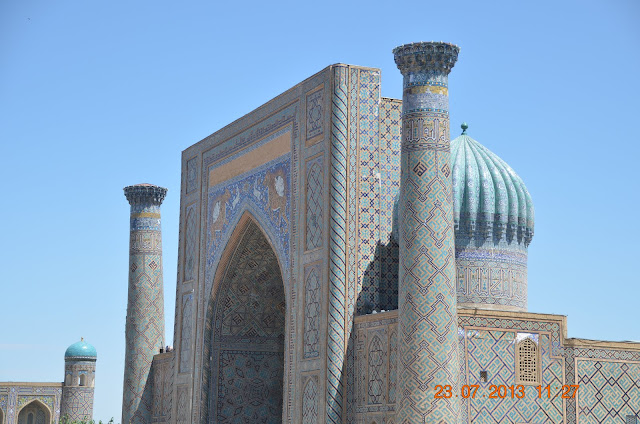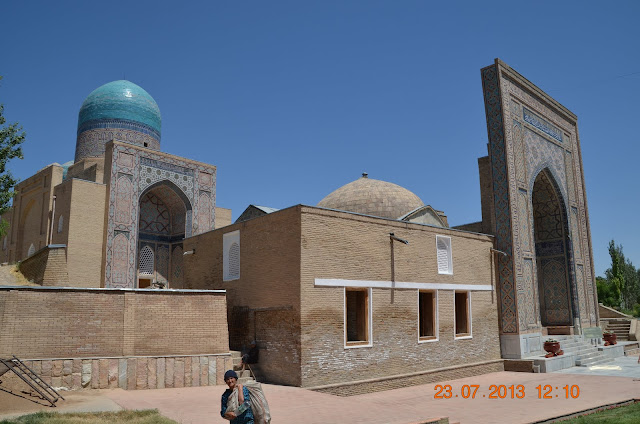Location: Samarkand, Uzbekistan
Date: 23 Jul 2013
One of three ancient stopping point along the old Silk Road, the city of Samarkand was once under the rule of the Timurid Empire. The Timurid were related to Genghis Khan, founder of the Mongol Empire, however, they were strongly influenced by Persian culture. The Uzbek captured Samarkand in 1500s and the city became part of the Khanate of Bukhara.
_________________
Registan
A complex with a public square and 3 madrasas built in the 15th to 17th century. It is the heart of the ancient city of Samarkand under the rule of the empire of Timur.
Ulug'bek Madrasah in the west with its mirror, the Sherdor Madrasah in the east and the Tillya-Kori Madrasah in the north completes the Registan Ensemble.
The Sherdor Madrasah was built by ruler of Samarkand, Yalangtush Bakhodur in 1619-1636
Sherdor means 'lion' and the name of this madrasah comes from the mosaic patterns on the madrasah's iwan. The pattern is unusual for Islamic architecture as it shows a lion (ie. student), a deer (ie. knowledge) and the sun (ie. enlightenment).
Tillya-Kori was built in the 1646-1660.
Unlike the other two madrasahs, Tillya also houses a mosque which is located on the western part of the building.
_________________
Gur-e Amir Complex
This mausoleum was completed in 1404 and was intended for Timur's grandson. Following his death a year later, Timur was also buried here, along with other members of his family.
_________________
Statue of Amir Temur
Statue of Timur sitting on the throne near the Gur-e Amir Complex
_________________
Rukhobod Mausoleum
A small mousoleum near Gur-e Amir Complex built in 1380 over the grave of Sheikh Burhaneddin Sagaradzhi, an islamic scholar who made significant contribution to the widespread of Islam among the Eastern Turkestan nomads.

_________________
Bibi-Khanym Mosque
This mosque built in early 1400s was once the largest and most magnificent mosque in the Islamic world.
Across the mosque is the Bibi-Khanym Mausoleum
_________________
Shah-i-Zinda
This mausoleum complex is the burial place for royals and noblemen. The Shah-i-Zinda is also an important pilgrimage site as it is said to contain the grave of Kusam ibn Abbas, the cousin of Prophet Mohammad, who preached Islam in Samarkand in 640 for 13 years.
15th century hammom
_________________
Xavrati Xizr (Hazrat Hyzr) Mosque
This mosque on a hill is not too far from Shah-i-Zinda and has a beautiful ornate ceiling made of wood.
_________________
Church of St Alexius Metropolitan of Moscow
Russian Orthodox church built during the period when Samarkand was under Soviet rule.
_________________
Sculptures in the park
_________________
Savdo Markaz (Savdo Market)
Bought some fish
Observing money changers from the balcony
Plov would be ready shortly...
Lunch is served.. it's plov (rice top with chickpeas, vege and meat) with tomato salad, bread and yogurt.. Drinks are served in bowls.
Plov (both a dish and cooking method similar to the pilaf and pilau of South Asia and the Middle East) is rice cooked in broth, with carrot, chickpea, and meat (mutton, lamb or beef).
And some pastry to top it off..
After lunch, we left Samarkand and headed north to Tashkent.
After lunch, we left Samarkand and headed north to Tashkent.





































































No comments:
Post a Comment